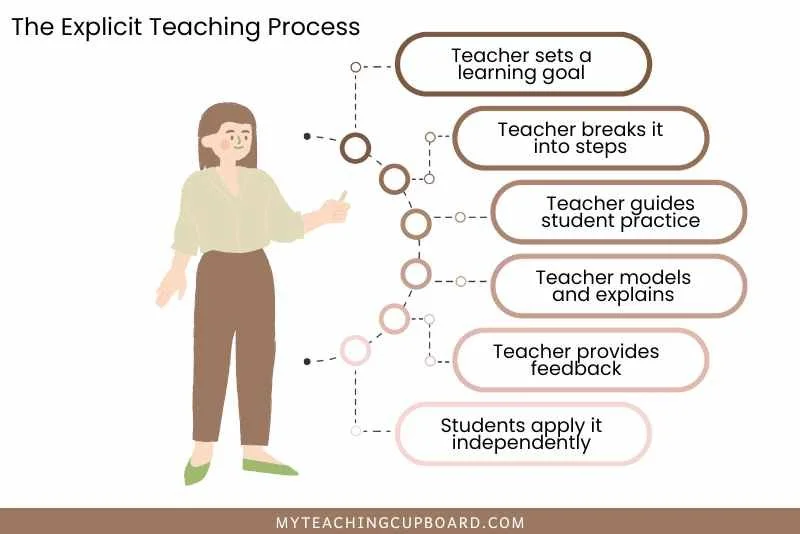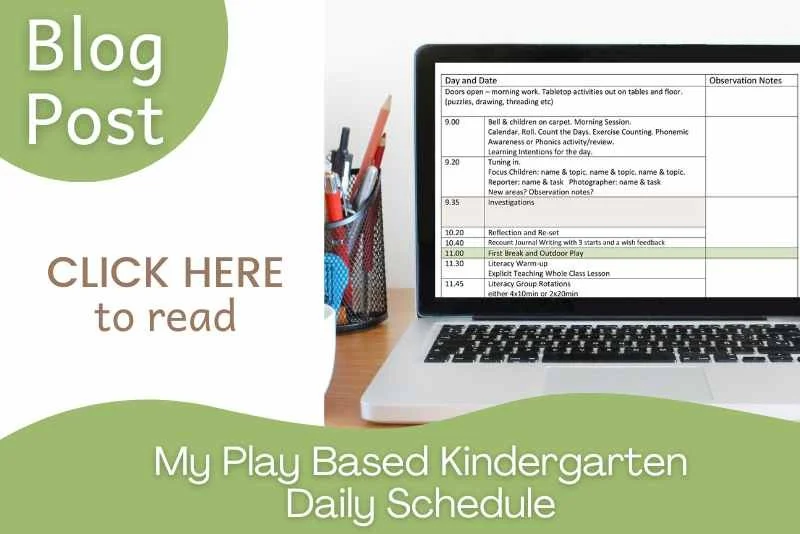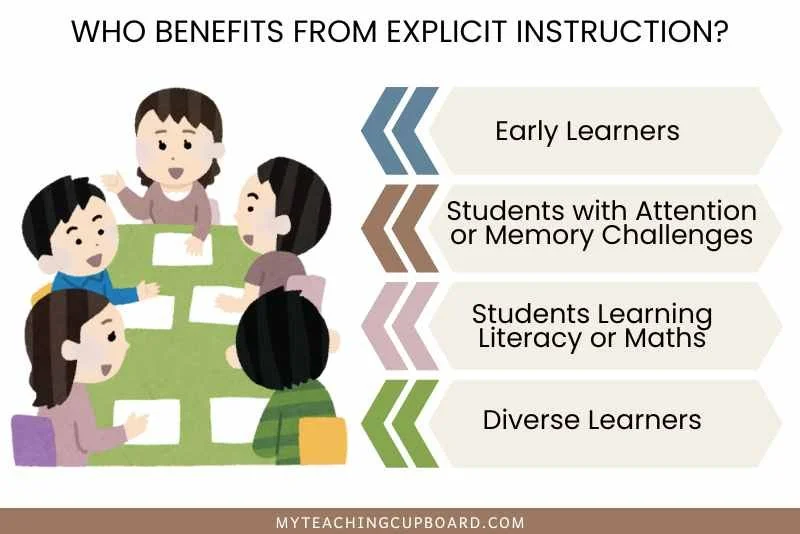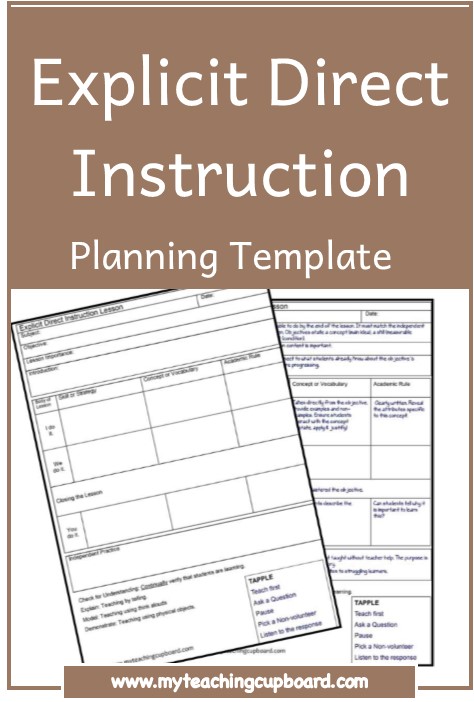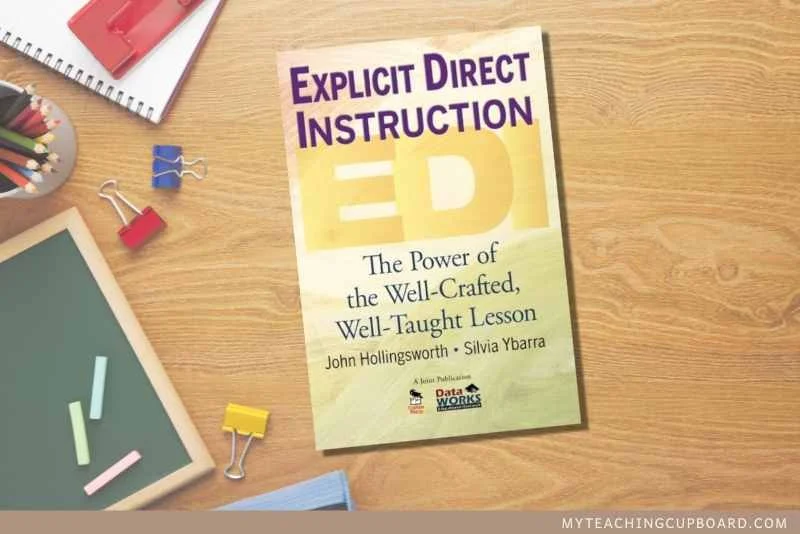What is Explicit Teaching in a Play Based Classroom?
Discover how to blend explicit teaching in a play-based classroom to boost student learning. Learn practical EDI strategies that support foundational skills while keeping play meaningful and engaging.
I stood in front of my class, ready to introduce a new concept. I had just 15 minutes before my students would scatter to their investigation areas, eager to explore and play.
If I didn’t make every second count, I knew they’d lose focus… and worse, they might not grasp the concept at all.
Have you ever tried to squeeze an important lesson into a short teaching window, only to feel like it didn’t quite stick?
It’s frustrating, isn’t it?
You know your students need explicit instruction to build strong foundational skills, but you also believe in the power of play-based learning. So how on earth do you do both?
The trick is not to choose between explicit teaching and play-based learning but to blend them together!
Both are important and necessary.
That’s why I consistently fall back on Explicit Direct Instruction (EDI) in my play based classroom.
Why Explicit Teaching Practices Matter in a Play-Based Classroom
Many teachers worry that explicit teaching is too rigid or too teacher-directed and that it doesn’t align with the joyful, student-led nature of play-based learning.
Others find themselves stuck, trying to juggle direct instruction and open-ended exploration in a way that feels natural and effective.
But here’s the truth: Explicit teaching doesn’t have to mean sitting students down for long, boring lessons.
When done well, it’s short, structured, and powerful - giving children the tools they need to succeed before and after they jump into hands-on learning.
Did you know research shows that Explicit Direct Instruction (EDI) is one of the most effective ways to help students learn new skills efficiently.
Studies on explicit teaching strategies highlight that it helps boost student achievement, reduce cognitive overload, and improve long-term retention.
What You’ll Learn in This Post
In this blog post, we’ll explore:
What Explicit Instruction is and why it’s so effective.
How to blend it with play-based learning so students get the best of both worlds.
Practical strategies for using explicit teaching in a way that feels age-appropriate and engaging.
A FREE EDI Lesson Plan Template to help you plan targeted, high-impact lessons in just 15 minutes or less.
You’ll also discover how to make explicit teaching and investigative play work together and reinforce each other so that your students continue learning long after the lesson ends.
What is Explicit Instruction?
Imagine trying to teach a child to ride a bike by simply handing them a bicycle and saying, “Figure it out”.
Some kids might get the hang of it through trial and error, but many would struggle, feel frustrated, or even give up.
Now, imagine instead that you demonstrate how to balance, explain how to pedal and steer, give them guided support, and then gradually step back as they gain confidence.
That’s Explicit Instruction in action.
At its core, Explicit Instruction is a structured, systematic instruction method where skills are broken down into manageable steps and taught directly.
Instead of leaving students to infer key concepts on their own, explicit teaching ensures they receive clear explanations, guided practice, and immediate feedback, helping them build knowledge efficiently and effectively.
Core Features of Explicit Teaching
Explicit Instruction follows a step-by-step approach designed to support student learning and understanding and minimise cognitive overload. The key features include:
Setting Clear Learning Objectives – Before students can succeed, they need to know exactly what they’re learning and why it matters. Each lesson should have a specific goal, often framed as a learning intention or success criteria.
Breaking Content and Complex Skills into Smaller Steps – Instead of overwhelming students with too much at once, explicit teaching presents new information in small, manageable chunks. This is especially important in early childhood, where attention spans are short, and concepts need to be scaffolded carefully.
Modelling and Thinking Aloud – Children learn best when they see a skill in action. By thinking aloud while demonstrating a process, you make the learning process visible and help students understand the steps involved.
Guided and Independent Practice – Students don’t just watch. They actively participate. First, they practise with teacher support (We Do), and then they apply their learning on their own (You Do).
Continuous Feedback and Assessment – Explicit instruction ensures frequent opportunities for students to receive corrective feedback. This helps prevent misunderstandings and reinforces learning before mistakes become habits.
Explicit Instruction vs. Discovery Learning: Are They Opposites?
A common misconception is that explicit teaching and play-based learning are at odds with each other. Some educators worry that structured, direct instruction might stifle creativity, while others feel that discovery learning alone isn’t enough to help students grasp complex tasks and concepts.
But here’s the truth: They aren’t opposites AND they work together!
Think of it like this:
Explicit Instruction builds the foundation. It ensures students gain the critical knowledge and skills they need to explore concepts meaningfully.
Discovery Learning reinforces and deepens their understanding. When students use what they’ve learned in hands-on, play-based experiences, they apply, test, and refine their knowledge in authentic ways.
For example, if I’m teaching 3D shapes, I’ll start with a short explicit teaching session where I introduce key vocabulary and demonstrate how to identify edges, faces, and vertices.
Then, during investigation time, I might place 3D blocks in the construction area and encourage students to trace their faces to find the 2D shapes within. This allows them to extend their learning independently while playing and creating.
The key is balance: Structured teaching provides children with the tools and confidence they need to explore, create, and apply their learning independently during play.
You might like this related blog post: My Play-Based Kindergarten Daily Schedule to see how I integrate short explicit teaching moments into our play-based day.
Who Does Explicit Instruction Help and What are the Benefits of Explicit Teaching?
Explicit Instruction is a powerful tool that benefits all learners. But for some students, it’s not just helpful - it’s essential.
Think about the child who struggles to retain instructions during a whole-class discussion. Or the student who needs extra support with numeracy concepts but gets lost in an open-ended maths investigation.
For these students, a short, clearly structured lesson can be the difference between understanding and frustration.
Explicit Instruction is Particularly Powerful for:
👉 Young Children in Early Years Classrooms
Young learners thrive on routine and clarity. They’re still developing their executive functioning skills, which means they need structured guidance before and after independent exploration. Explicit teaching provides them with clear expectations, so they know what to focus on before engaging in hands-on learning.
For example, before a maths-based investigation, I might teach a short explicit lesson on number patterns, modelling how to create and extend a pattern using loose parts. This structured introduction gives students a strong foundation before they head off to explore pattern-making at an investigation area.
👉 Students Who Struggle with Attention or Working Memory
Some children find it difficult to hold onto multiple pieces of information at once. They might struggle with multi-step instructions or lose focus when a lesson is too abstract.
Explicit teaching reduces cognitive overload by presenting new learning in smaller, manageable chunks. This allows your students to process concepts one step at a time.
Did you know that research on Cognitive Load Theory suggests that breaking lessons into bite-sized steps helps students learn more effectively because it prevents their working memory from becoming overwhelmed.
👉 Children Learning Foundational Skills in Literacy and Numeracy
Before children can write independently, they need to understand phonemic awareness, letter formation, and sentence structure.
Before they can solve mathematical problems, they need a strong grasp of number sense, patterns, and operations.
Explicit teaching ensures that these foundational skills are introduced using a clear, systematic method. You need to make sure to build your children's confidence and competence if they are to have success in open-ended play or inquiry-based learning experiences.
👉 Students in Diverse Classrooms
Every classroom has students with different learning needs, backgrounds, and abilities.
Explicit instruction is an inclusive teaching strategy because it allows teachers to:
Differentiate their teaching by adjusting the level of guidance for different students.
Support multilingual learners by explicitly teaching vocabulary and concepts.
Ensure equity by providing all students with the knowledge they need to succeed - rather than assuming they will figure it out on their own.
Why Does This Matter?
🟢 When children understand concepts clearly, they are more likely to engage confidently in learning experiences.
🟢 Explicit teaching removes unnecessary barriers so all students, regardless of their starting point, can succeed and thrive.
🟢 When paired with play-based learning, Explicit Direct Instruction gives students the best of both worlds - structured support and open-ended exploration.
If you are interested in exploring how I create learning spaces that reinforce explicit teaching concepts through play, check out this related Blog Post: The 10 Essential Areas of a Play-Based Classroom
Want a practical way to integrate explicit teaching into your play-based classroom?
Download my FREE EDI Lesson Plan Template and start planning high-impact lessons today!
Why Use Explicit Teaching Strategies?
If you’ve ever wrapped up a lesson and thought, Did they actually get that? - you’re not alone!!
Teachers often wonder if students are truly absorbing the new concepts we are introducing. That’s why I love using explicit teaching strategies.
Explicit teaching takes the guesswork out of learning by ensuring that students receive clear, structured instruction before being expected to apply new skills independently.
It’s about making every minute count so your students feel confident and ready to explore.
What Makes Explicit Teaching So Effective?
Research-backed approach – Studies show that explicit instruction improves learning outcomes by providing small, structured steps, frequent feedback, and high student engagement.
Ensures consistency – All students, regardless of their learning needs, receive clear and consistent instruction, helping to bridge gaps in understanding.
Maximises learning in short bursts – In a play-based classroom, time is precious. Short, targeted explicit lessons ensure children get the foundation they need before heading off to investigations.
Builds student confidence – When children experience success in structured learning, they’re more willing to take risks and apply their knowledge creatively during play.
Explicit Instruction in Action
Let’s say I’m introducing the concept of patterns in mathematics.
Sometimes, we jump straight into explorations, and I set up an open-ended loose parts play invitation. Most children will naturally begin making patterns when given loose parts to explore. In this case, I observe closely, watching for their skills and understanding. This informs my explicit teaching lessons that follow and helps me tailor my instruction to their needs.
Other times, I already have a good understanding of where my students are at, so I begin with an explicit lesson where I model how to create and extend a pattern using loose parts. I guide the class in a few examples together, checking for understanding as we go. Then, I encourage independent exploration by setting up a patterning provocation at an investigation area.
Because students already have a clear understanding of what a pattern is and how to use the loose parts resources to make patterns, they are more likely to extend, manipulate, and experiment with patterns creatively in their play.
Why Explicit Instruction Lessons Matter
When explicit teaching is done well, it empowers students to engage more deeply in learning. It ensures that play-based learning isn’t just exploration for the sake of it and that is is an opportunity for children to apply and reinforce concepts they genuinely understand.
I spend most of our school day mixing explicit teaching with play based hands-on exploration and I consistently get good results.
Check out this blog post: My Play-Based Kindergarten Daily Schedule to see how I blend explicit teaching and play-based learning throughout the day!
Want a ready-to-use template for structuring your explicit teaching lesson plans?
How to Teach Using Explicit Direct Instruction (EDI)
Explicit Direct Instruction follows a structured, step-by-step approach that helps children grasp critical content before moving into independent learning.
One of the most effective ways to implement EDI is through the I Do, We Do, You Do model. This gradual release of responsibility ensures that your students will have the right level of support at the right time, allowing them to build confidence before applying their learning independently.
The I Do, We Do, You Do Model
1. I Do: Teacher Modelling
This is where you introduce the concept and provide a clear, structured demonstration of what students need to learn.
Explain the concept in simple terms. Keep your language clear and concise, making sure students understand the purpose of the lesson and the learning objective.
Model using think-alouds. Show your thinking process out loud. Like: I notice this 3D shape has flat faces, so I can trace them to find 2D shapes.
Provide clear examples and non-examples. This helps students recognise patterns and understand when to apply the skill.
💡 Tip: Using a visual anchor such as a PowerPoint, chart, or real-life objects helps make abstract concepts more concrete for young learners.
2. We Do: Guided Practice
Now, students begin to actively participate while you guide them through the process.
Work with students to complete the task together. This could involve joint discussions, solving problems as a group, or using manipulatives to explore the concept.
Ask questions to check for understanding. Open-ended questions like What do you notice? or Can you explain why this happens? encourages deeper thinking.
Encourage students to explain their thinking. Have them describe their observations and reasoning to reinforce learning.
💡 Tip: This stage is not about getting the 'right' answer immediately. It is more about giving students the confidence to attempt, adjust, and refine their understanding through discussion and exploration.
3. You Do: Independent Practice
At this stage, your students will take full ownership of their learning, applying what they’ve learned independently or in small groups.
Provide scaffolds if needed. Some students may need additional support, such as a reference chart, a peer buddy, or manipulatives to help them work through the task.
Offer feedback to refine their understanding. Observe closely and provide immediate feedback to correct misconceptions before they become ingrained.
Encourage your students to apply the skill in different ways. This helps reinforce learning and deepen student understanding.
💡 Tip: If students struggle, return to the "We Do" stage to provide additional support before expecting full independence.
Explicit Instruction in a Play-Based Classroom: A 3D Shape Example
Here’s what the I Do, We Do, You Do model might look like when teaching 3D shapes in a play-based classroom:
I Do – I introduce 3D shapes in a short explicit teaching session, showing the key features of prisms, cubes, and cylinders. I trace the flat faces of each shape and model how to count edges and corners.
We Do – Together, we trace different 3D shapes onto paper and discuss what we see. I guide students through identifying the 2D faces within the 3D shapes, asking questions like, What do you notice about this shape? Where else might we see this shape in the real world?
You Do – I place 3D shapes in the block area for children to explore independently. Some students choose to trace the faces of the shapes, while others use them in their block constructions. I encourage students to photograph, trace, or describe their constructions, so we can reflect on their discoveries later.
💡 Why This Works: Because the explicit teaching session gives students the foundational knowledge first, they can then apply their learning in a hands-on, creative way. This reinforces their understanding through hands-on exploration and play.
After watching a One Channel session on Explicit Teaching, I ordered this book: Explicit Direct Instruction - The Power of the Well-Crafted, Well-Taught Lesson by John R. Hollingsworth and Silvia E. Ybarra.
And I am so glad I did. I have just finished reading it and it makes so much sense to me.
This text offers a proven method for better teaching and better learning. It presents a step-by-step approach for implementing the Explicit Direct Instruction (EDI) approach in classrooms. It is based on educational theory, brain research, and data analysis.
EDI helps teachers deliver effective lessons that can significantly improve achievement in all grade levels. The authors discuss characteristics of EDI, such as:
checking for understanding
lesson objectives
activating prior knowledge
concept and skills development
guided practice.
I like how they provide clearly defined lesson design components. There are even detailed sample lessons with easy-to-follow lesson delivery strategies. The text even has scenarios that illustrate what EDI techniques look like in the classroom.
Here are the lesson components from this text, broken down:
Objective: The purpose of the objective is to describe what students will be able to do by the end of the lesson. It must match the independent practice and be clearly stated to the children. Objectives state a concept (main idea), a skill (measurable student behaviour) and sometimes a context (condition).
Lesson Importance: Teaching why the lesson content is important is called TIB at our school. TIB stands for This Is Because.
Lesson Introduction: This is where you activate children's prior knowledge and connect to what students already know about the objective’s concept or skill. Check for understanding before progressing in the lesson. In fact, it is recommended that you check for understanding continuously throughout the entire lesson.
Body of the Lesson: Consists of the three main parts taken directly from the lesson objective. The I do, We do and You do part.
Independent Practice (You do): During Independent practice students successfully practise exactly what they were just taught without teacher assistance. The purpose here is repetition. Repetition helps the students remember & store the new information in their long term memory.Independent Practice time is the perfect opportunity for the teacher to provide in-class intervention to struggling learners.
Points to Remember from the Text
Check for Understanding continually.
Verify that students are learning.
Explain: Teaching by telling.
Model: Teaching using think alouds.
Demonstrate: Teaching using physical objects.
In my FREE Resource Library, you'll find the planning template I use for the Explicit Direct Instruction lessons I do in my classroom. The FREE Resource Library also has over 70 other teaching resources I know you'll find useful.
The 17 Elements of Effective Explicit Instruction
Barak Rosenshine’s research on effective teaching also provides a clear roadmap for how to structure lessons so that students grasp new concepts efficiently. His 17 principles are backed by cognitive science, studies on master teachers, and research on instructional supports.
For early years teachers, these principles are particularly valuable because young children thrive on clear, structured learning experiences that build confidence and understanding.
Rosenshine's 17 Principles of Effective Instruction
Here’s how his 17 research-backed strategies apply in an early years classroom:
Begin a lesson with a short review of previous learning and background knowledge.
Example: Before introducing a new mathematical problem or concept, spend a few minutes reviewing what children already know to build connections.Present new material in small steps with student practice after each step.
Example: Instead of explaining all the features of 3D shapes at once, introduce one feature at a time and let students explore it before moving on.Limit the amount of material students receive at one time.
Young children have short attention spans—keep explicit teaching moments short and focused.Give clear and detailed instructions and explanations.
Instead of saying, Sort these objects, specify: Sort these by colour first, then sort by shape.Ask a large number of questions and check for understanding.
Use questions to encourage thinking: What do you notice about this pattern? What comes next?Provide a high level of active practice for all students.
Make sure every child is engaged. Use hands-on materials, whiteboards, or partner discussions. Set up investigation areas targeting specific skills practice.Guide students as they begin to practice.
Example: When teaching letter formation, model the strokes and guide children through tracing before they attempt it independently.Think aloud and model steps.
Show children how to work through a problem or concept step by step, verbalising your thought process.Provide models of worked-out problems.
Example: Show a completed number pattern and talk through how it was made before asking students to create their own.Ask students to explain what they have learned.
Encourage children to describe their thinking: How did you figure that out?Check the responses of all students.
Use thumbs up/down, whiteboards, or partner discussions to make sure every child is engaged.Provide systematic feedback and corrections.
If a child misunderstands a concept, correct gently: Let’s try that again together and see if we can spot what happened.Use more time to provide explanations.
For difficult concepts, slow down and provide extra demonstrations before expecting independent practice.Provide many examples.
Example: When teaching shapes, use real objects, pictures, and hands-on manipulatives to reinforce understanding.Reteach material when necessary.
If children struggle, revisit the concept using a different approach rather than moving on too quickly.Prepare students for independent practice.
Before letting students explore a skill on their own, ensure they’ve had enough guided practice to feel confident.Monitor students when they begin independent practice.
Walk around, observe, and support students as they explore concepts in play-based learning areas.
Key Takeaways for Early Years Teachers
These 17 principles can be adapted to play-based classrooms by ensuring explicit teaching moments support and extend learning rather than replace child-led inquiry.
Break skills into small, manageable steps. Don’t overload children with too much new content at once. Present new learning in bite-sized pieces so they can process it effectively.
Review prior knowledge before teaching new content. A quick review of past learning and prerequisite skills helps students connect new information to what they already know.
Model and demonstrate using clear language. Show students exactly what to do by thinking aloud, using visuals, and providing clear, simple explanations.
Provide guided practice and immediate feedback. Young learners need frequent, hands-on practice with immediate support to build confidence and avoid misconceptions.
Ensure students practice and apply their learning over time. Space practice so students revisit skills across different lessons and through investigative play sessions to improve retention and mastery.
How These Principles Work in a Play-Based Classroom
When explicit instruction is paired with play-based learning, children get the best of both worlds - structured support and the freedom to explore and apply their knowledge in meaningful ways.
For example:
Before setting up a literacy invitation with playdough, explicitly teach the letter formation of the letters you are learning and model how to use playdough to create those letters.
Before an open-ended block play session, introduce key maths concepts like symmetry or measurement, so students notice and apply them naturally.
Before an investigation on floating and sinking, model how to make predictions and test different materials in water.
When students have explicit knowledge before exploring, their play becomes richer, more meaningful, and more connected to the curriculum.
Make Explicit Instruction Work for You
Teaching explicit concepts in a structured yet engaging way doesn’t have to be overwhelming.
With the right planning, you can ensure your explicit teaching time is effective, concise, and impactful.
📥 Download my FREE EDI Lesson Plan Template to help you structure powerful, high-impact lessons.
Explicit Instruction and Play-Based Learning: A Perfect Balance
Some educators worry that an explicit approach is too structured and yet others think that purely exploratory play is a free-for-all and lacks the guidance students need to develop foundational skills.
But here’s the reality: The most effective classrooms blend both approaches!
Explicit instruction lays the foundation, ensuring that children develop key knowledge and skills.
Play-based learning then reinforces and extends those skills through meaningful, hands-on exploration.
One approach is not better than the other - they work together to create rich, balanced learning experiences.
How Explicit Teaching and Play-Based Learning Reflect Each Other
Explicit Teaching Gives Students a Roadmap: It introduces a new concept clearly and concisely, helping students develop confidence before they explore further.
Play-Based Learning Deepens Understanding: After receiving structured instruction, children can apply, manipulate, and experiment with what they’ve learned in a way that feels natural and engaging.
Here's an example:
For an explicit lesson on patterns, first model how to create and extend a pattern using loose parts. Then for guided practice, work with your students to create different patterns. Ask questions like "What comes next?" and "How do you know?" Then provide opportunities for independent exploration. Set up a math provocation with pattern blocks so your children can continue exploring in their own way.
Because students already understand the concept, their play becomes richer and more intentional. They’re not just playing with blocks and loose parts - they’re independently noticing patterns, creating sequences, and testing new ideas.
Explicit Teaching Supports Independence in Play
When children know how to use materials, they feel more confident exploring without adult intervention.
Think about a loose parts play invitation. If children have never been explicitly taught how to sort, create patterns, or compare sizes, they might not use the materials in a way that links to your curriculum learning intentions.
But if they’ve had a short, targeted explicit teaching session beforehand, they are more likely to naturally incorporate those skills into their play.
Here’s another example:
Before placing 3D shapes in the block area, explicitly teach your children to identify the faces, edges, and corners. As they explore the shapes in the blocks area they are more likely to begin noticing connections between different shapes, stack them to build stable structures, or even trace the faces to create shape designs.
This is why explicit instruction can empower your students. Giving them the knowledge they need to can take charge of their own discoveries.
Why This Leads to an Effective Teaching Practice
Balancing explicit teaching with play-based learning ensures that children:
Gain essential skills through structured instruction.
Feel confident applying those skills in self-directed play.
Learn in a way that is meaningful, engaging, and developmentally appropriate.
Explicit instruction and play are the tools effective teachers use. By thoughtfully combining these tools, you’ll be on your way to creating a classroom where your children thrive, explore, and build deep, lasting understanding.
Learn how to design engaging and purposeful learning invitations that reflect your curriculum learning intentions and build on your explicit teaching lessons in this blog post: 3 Steps to Setting Up a Learning Provocation
Confident Teaching and Engaged Learning
Teaching in a play-based classroom is all about balance.
You want to honour child-led learning, but you also know that some skills need to be explicitly taught for children to build a strong foundation.
That’s why explicit instruction doesn’t replace play-based learning - it works alongside it and enhances it!
When you blend Explicit Direct Instruction (EDI) with hands-on, play-based investigations, you create a powerful learning environment where children:
Receive clear, structured teaching so they can grasp new concepts with confidence.
Apply and extend their learning through play, making deeper connections to the curriculum.
Develop independence, because they know how to use materials and ideas in creative ways.
Maximising learning in a play-based classroom isn’t about choosing between explicit instruction and play. You should be using both strategically.
By incorporating short, structured explicit teaching sessions, followed by rich hands-on investigations, you can rest assured that your children will have the tools they need to thrive, experiment, and grow as learners.
Your Next Steps to Optimal Use of Instructional Time
Streamline your explicit teaching sessions and Download my FREE EDI Lesson Plan Template and ALSO get access to 70+ free resources designed to help you teach more effectively!


